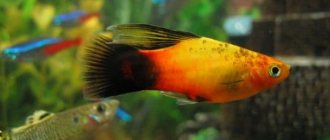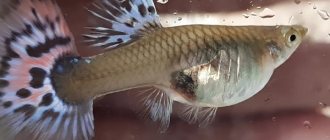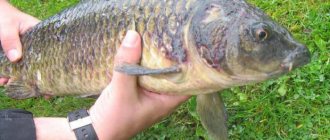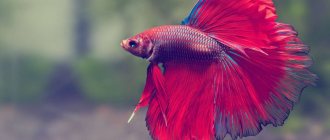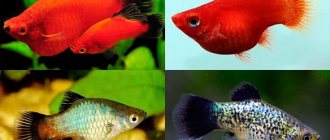Modern platies for aquariums are the result of the work of breeders. It was they who helped develop so many species of these fish and give them unusual colors. In nature, platies are larger and less noticeable. They live mainly in the lower reaches of rivers flowing into the Atlantic Ocean. The most beautiful species in their natural habitat were seen near Yucotan.
Common types of platies
Aquarists encounter different types of platies. In pet stores you can find breeds of different origins.
| Breed type | Name | Description |
| Natural | Spotted (Xiphophorus maculatus) | Golden scales, males up to 3.5 cm long, and females up to 5. |
| Multicolor (Xiphophorus variatus) | It has several color options and a rounded tail. Body length 5-6 cm. | |
| Steel body with inclusions. Montezuma's swordtail has an interesting elongated tail. | |
| Breeding | Pecilia radish | The caudal fin is black and resembles a brush, and the color of the body and head is most often bright red. |
| Flag | Large breed, with a body length of up to 7 cm. The dorsal fin is triangular. Body color can vary; individuals with a black body and yellow fins and outlines are more common. | |
| Black | It has iridescent scales and a peaceful disposition. It is often crossed with swordtails. | |
| Coral | A breed with an unusual blurred color in red-orange tones. | |
| Red | It has a fiery red body and translucent fins. | |
| Disk | It is distinguished by a rounded body shape. She needs to select peaceful and slow neighbors, since this fish is not particularly agile. There are different colors of this breed:
| |
| Blue (neon) | It is distinguished by its large body and bright blue body color with a silver belly. Grows up to 7 cm. | |
| White | As a result of selection, it was possible to breed an albino fish, whose internal organs can be seen through the transparent scales. It is noteworthy that this color is not transmitted at the genetic level. | |
| Mickey | It is distinguished by its yellow body, and its tail has spots similar to the outline of Mickey Mouse. | |
| Schwartz | A resinous stripe with a greenish tint runs along its body. |
In total, there are more than 130 breeding forms, among which there are options with unusual fins and tail.
Origin story
Several species of fish are considered platies, all belonging to the Cyprinodontiformes family. They are bred by beginners and experienced aquarists; they are often mistaken for mollies; on the one hand, they are a type of platie.
Guatemala and Southern Mexico are considered to be the birthplace of the fish, but they have spread throughout the planet. Europeans began breeding them in 1907, and the platie fish became popular throughout the world. Wild platie is found in the lower reaches of rivers flowing into the Atlantic Ocean; it is not distinguished by its bright color, unlike domestic representatives.
In aquariums there are three species of fish from which the varieties originated: the southern one, the spotted platy, and the swordtail. The platies crossed with the swordtails, so their descendants are difficult to distinguish. The only sign is the presence of a sword-shaped process; if there is one, it is a swordtail; if it is not, it is a platy.
- The southern highfin platie was first mentioned in 1886, the spotted platy in 1904, and the green swordtail in 1932. All platies interbreed. It is a popular species for breeders and aquarists, unpretentious care and maintenance, so it is readily kept as an aquarium pet; thanks to this species, many other varieties with unusual colors have appeared.
- Thanks to the spotted fish, many varieties of these fish with natural colors have appeared.
- The green swordtail has been studied little, it is not common, but it is becoming a popular species; breeders continue to cross swordtails and platies, producing unusual varieties of platies.
- Wild ones prefer to live in warm waters, swamps and springs. The southern one normally tolerates a small current, but the green swordtail does not tolerate a large current. Fish prefer to swim in the company of representatives of their own species.
How to keep a platie
Do not put a small number of fish into the aquarium; there should be more than 6-8 of them (try to have 2-3 females for every 1 male). It is best to choose a spacious tank, since platies multiply very quickly. It is best to choose a capacity option from 40-50 liters.
It is better to set up an aquarium according to the following rules:
- Place a lid on top to prevent the fish from jumping out during active games.
- It is important for individuals to create coziness with the help of artificial lighting, for which you can use a regular table lamp with low power. The tank should receive natural light, but not direct sunlight.
- The interior of the aquarium must be equipped with shelters and plants. Walnut shells, driftwood, stones, and branches are suitable. Plant hornwort and elodea along the back and side walls. There should be room between them for the fish to move, but there should be a lot of plants. Leave the foreground free.
- Fill the bottom of the container with dark soil to make the fish look better.
- Install the filter and aerator.
Replace some of the water with fresh water weekly. If it is not hard enough, add marble chips to the soil.
Aquarists often add salt to the water for platies, as this disinfects it. Salt helps prevent disease, especially in young animals.
Adviсe
- If overfeeding occurs, immediately remove excess food from the aquarium with a net.
- When purchasing fish food, carefully study the expiration date and storage conditions. Avoid loose feed.
- When breeding fish, select fish of the same variety, so the offspring will be purebred.
- When spawning, remember that a lot of offspring appear. Make sure you have a large aquarium.
- When buying pets in a store, carefully inspect the fish. She should not show signs of illness.
- New fish should be introduced into the aquarium gradually. First, place the bag in the aquarium for half an hour, then pour some aquarium water into the shipping bag. Gradually add aquarium water.
Pecilia is a beautiful and unpretentious fish that is perfect for beginners. An interesting feature: if the conditions of detention change sharply, the fish changes sex. Thus, the female becomes a male.
Previous Fish7 popular aquarium cichlid fish and their maintenance Next Fish16 types of koi carp for the aquarium
What and how to feed your platie
| Live food (at least occasionally) | Dry food (basic diet) | Top dressing |
| bloodworm; tubifex; coretra; daphnia; aulophorus. | daphnia; gammarus; ready-made industrial compositions (Tetra Min Rubin and Tetra Pro Colour). | spirulina flakes; cucumbers, zucchini; steamed semolina; washed bread crumb. |
It is best to give preference to live food, and give dry food less often. Plant foods are the least needed by platies, but you shouldn’t forget about them at all, since they are needed for the normal functioning of your pets’ gastrointestinal tract. If you do not give them plant food, they will begin to eat the green parts of plants.
Give food 1-2 times a day in such portions that they last for 5-7 minutes. If after this time there is food left on the water, remove it.
Fish breeding process
Platies are viviparous fish. They reach sexual maturity at 6-7 months of age. For spawning, they do not have to be placed in a separate tank; the process also works well in a general aquarium. The survival rate of the fry is good due to the fact that they develop inside the mother's abdomen.
If you place males and females together, then you will not have to interfere with the breeding process. In this case, all you have to do is control it, since platies are very prolific. A pregnant female is easily distinguished by its rounded abdomen and darkened scales around the anus.
During one spawning, she is capable of producing from 30 to 50 fry. If you do not control this process, then the addition of offspring will occur monthly.
After spawning, it is best to remove the adult female, otherwise she will destroy part of the offspring. Most aquarists prefer to place females in a separate aquarium during spawning, and then return them to the general one. The conditions of detention for individuals during breeding do not change. After birth, fry need to be fed up to 6-7 times a day with starter feed and live dust.
Description
Pecilia is a small fish, body length reaches 3.5 - 5, and life expectancy is about 3-4 years. As for appearance and coloring, they can be very different; it is simply impossible to describe everything.
We can only mention the disc platie, a specially bred form with a curved spine and, due to this, a special body shape, it is also called balloon platie.
Actually, there are no differences in content between a regular platy and a balloon. The latter, due to deformation of organs and skeleton, are more capricious.
What fish and plants can be kept together?
In one aquarium you can place several species of platies or representatives of other peace-loving breeds:
- guppy;
- iris;
- catfish;
- rasboras;
- apistograms;
- swordtails;
- tetras;
- gourami;
- cardinals;
- zebrafish
They are incompatible with aggressive and large fish: carnivores, piranhas, cichlids. You should not house them with representatives of the carp family, as their temperature differs.
Compatibility with other fish in the aquarium
The difference between Platies is their calm nature, which played an important role in the popularity of their breeding. Therefore, they get along well with their own type of fish. Guppies, Swordtails and other similar species of aquatic inhabitants will feel comfortable in the neighborhood of Platies. Examples of phenotypes that will ideally get along with: Neon, Angelfish, Cardinal shrimp, Tetra, Rainbowfish, Botia, Discus, Gourami, small Catfish.
But it is better to abandon the idea of placing calm pets with large and violent fish of this type, such as: Cichlids, Barbs, Cockerels and Astronotuses.
Probable diseases
With proper care, platies can live up to 5 years. The main enemy to their health is dirty and cold water. Common diseases of this type:
- Fin rot - with this disease, the fish develop red spots and gray sores on the body. The fins curl unnaturally and erosion occurs. Simple sanitary standards will help prevent the disease: regular filtration and aeration of water, replacing part of its volume.
- Ichthyophthiriasis is an immune disease that can be identified by the formation of a white coating on the fins. To treat individuals, they are immersed in salt baths and the drugs Bicillin 5 and Rivanol are used. Pathology appears due to the friction of the fish against the ground and stones.
- Fungal infections - with them, a white air coating, reminiscent of cotton wool, forms on the scales. Sick fish should be moved into a separate container, and the water in the general aquarium should be completely replaced.
Diseases rarely occur in platies; in most cases, they are caused by the neglect of their owners.
These Mexican fish can please the eye for a long time. Most of their species are active, so it is very interesting to watch them. If you are lucky, you will notice a unique property of platies - rebirth. Females of this species are capable of turning into males.
Habitat
The aquarium fish platie belongs to the genus Cyprinodontiformes, viviparous. The family includes about 30 species of these wonderful creatures, but to a greater extent this is the merit of breeders who are engaged in breeding and crossing different breeds.
In nature, platies live in fresh or brackish standing water. The bottom of the reservoir should be with silty soil and overgrown with vegetation. The fish are native to the south of America and Mexico.
Under natural conditions, the appearance of the fish is less bright than that of their artificially bred relatives. The body is short, dense, with a large fin. The color is usually yellow with black spots interspersed on the sides. The dimensions do not exceed 6 cm. It is difficult to say for sure how long fish live in nature, because they are often eaten by predators, but in aquariums their life expectancy is 3-4 years.
Depending on the water, they change the contrast
Due to their modest size, platies reproduce by viviparity, but they were not always able to do this. Rather, this can be called the result of an attempt to preserve their species, because their caviar is a delicacy for many other inhabitants of water bodies. But the platies themselves do not hesitate to taste other people’s eggs. In addition, in their natural environment, fish are sometimes able to change their sex, but only under extreme conditions.

